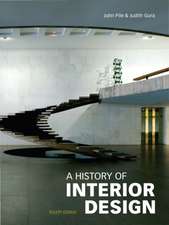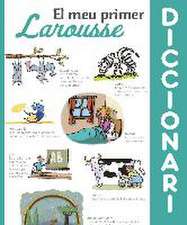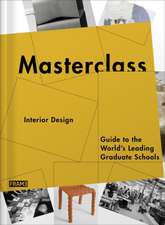Lighting for Interior Design: Portfolio Skills
Autor Malcolm Innesen Limba Engleză Paperback – 19 aug 2012
Preț: 156.81 lei
Preț vechi: 204.42 lei
-23% Nou
30.01€ • 31.29$ • 24.94£
Carte disponibilă
Livrare economică 27 februarie-13 martie
Livrare express 13-19 februarie pentru 90.47 lei
Specificații
ISBN-10: 185669836X
Pagini: 192
Ilustrații: 304
Dimensiuni: 216 x 278 x 16 mm
Greutate: 0.75 kg
Ediția:New.
Editura: LAURENCE KING
Seria Portfolio Skills
Notă biografică
Malcolm Innes is a lighting designer, a light artist and lighting educator. He has lectured internationally on the subjects of light, art and architecture and he teaches on the MDes Lighting, BDes Interior Architecture and BDes Design and Digital Arts programmes at Edinburgh's Napier University. He is also an active member of the Professional Lighting Designers' Association.
Cuprins
8 PART I THEORY 10 1. The physics of light 11 What is light? 12 The physical properties of light - what designers need to know 13 Reflection 14 Mirrors 15 Transparency 16 Filters and lenses 18 Refraction 19 Shadows 20 What is colour? 24 Quantifying light 25 Luminance 25 Candela 25 Lumen 25 Luminous flux 25 Lux 25 Illuminance 25 Light meters 26 2. Human factors 26 Sensing light 27 Adaption 28 Experiencing changes in light levels 29 Eyes and the sense of sight 30 Stereo vision 32 Motion detection 33 Low light sensitivity 34 Light and psychology 34 How do we see? 35 Preferences 36 3. Natural light 36 What do humans need? 38 Sources of natural light 40 Range of intensity 41 Direction of natural light 42 Colour and natural light 45 Daylight control 46 Case study: Architecture Gallery, Victoria & Albert Museum, London, UK 48 4. Electric light 49 Sources of electric light 49 Incandescent light sources 50 Discharge light sources 55 Electroluminescent light sources 57 Luminaires 58 Dispersive and directional luminaires 59 Concealed luminaires 59 Manufacturer's data 60 Generic luminaire types 62 Visualizing patterns of light 64 Visualizing spotlight data 65 Isolux diagrams 66 Lighting control systems 68 Mains voltage dimming 70 Electronic dimming 72 PART II PROCESS AND PRACTICE 74 5. Lighting principles 74 Visual hierarchy 76 Understanding qualities of natural light 77 Understanding layers of light 79 Change and variation 80 Creating drama through lighting 82 Changing and controlling light 86 Surfaces and texture 88 6. Lighting for people 88 How much light is enough? 90 Lighting for comfort and safety 91 Task lighting 92 Lighting for orientation 94 Step by step: Lighting a corridor 96 Case study: Wayfinding: Terminal 2F, Charles de Gaulle Airport, Paris, France 98 Avoiding glare 100 Case study: Low light gallery, St Mungo's Museum of Religious Life and Art, Glasgow, UK 102 7. Lighting for architecture 102 Ambient lighting 106 Accent lighting 110 Case study: One Gyle Square, Edinburgh, UK 114 Case study: Sheikh Zayed bin Sultan Al-Nahyan Mosque (The Grand Mosque), Abu Dhabi, UAE 120 Lighting vertical surfaces 121 Integrating light with architecture 122 Case study: Morimoto Restaurant, Philadelphia, USA 126 8. The design process 128 Researching the project 128 Analysis of needs 129 Outline proposal stage 129 Detail design stage 129 Construction stage 129 Final focus and programming 129 Client handover 130 Case study: St Machar's Cathedral, Aberdeen, UK 140 9. Recording and visualizing lighting 141 Drawing and sketching 142 Abstract representation 144 Diagrammatic representation 146 Photography 148 Computer renders as a design tool 150 Physical models 154 10. Project communication and completion 155 What is enough information? 156 Sections and elevation drawings 158 Case study: Musee de l'Orangerie, Paris, France 162 Lighting renders 164 Step by step: Using computer models 166 Recording circuiting and control intent 168 Use of sketch details 170 Lighting mock-ups and tests 172 Specification documents 172 Generic specification 172 Detailed specification 174 Realizing the project 175 Final focusing and programming
Descriere
Without light, interior architecture cannot be fully designed and experienced. It is one of the key tools for an interior designer, but can be a dauntingly technical subject for students. Part One, Theory, looks at the physics and technology behind lighting. Part Two, Process and Practice, looks more specifically at the use of lighting in interior design and outlines the key design issues and principles. The book goes on to show the ways of representing lighting schemes using CAD and 3D models and how to implement and test these designs. Finally, the book explains how to deal with contractors, clients and other professionals. This book takes a detailed, practical look at lighting in interior design, giving students all the key information and skills they need to be able to tackle lighting successfully in their designs.

















